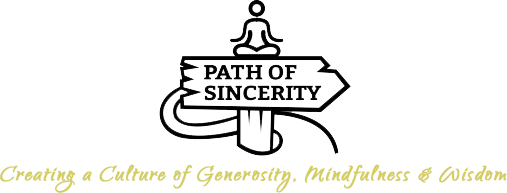
The Overarching Approach to Thinking in Insight Meditation
In Mindfulness/Insight/Vipassana meditation, we are not trying to get rid of thinking, ignore it, or make it stop. Thought is a necessary function of mind—without it we would literally be incapable of functioning in society.
However, there is a HUGE difference between skillfully using thinking, and doing what most people do: bouncing from one thought to the next, endlessly swirling in long chains of verbal thinking (usually about the “story of me”).
In turn, rather than getting rid of thinking, the objective of Vipassana is to break the habit of obsessive thinking—more specifically, it’s to build up enough awareness+wisdom that we can let thoughts float by without indulging them.
As our practice develops, we start to experience thoughts sort of like how we experience tastes, sounds, smells or body sensations. They stop feeling so “sticky.” We can notice them floating through awareness, but have a very real sense of choice on which ones we think and which ones we allow to keep on floating.
As a general rule, our formal meditation practice is a time to train ourselves to let just about all thoughts keep on floating. There can be exceptions to this rule, but best not to overcomplicate it — learn to not indulge every enticing thought!
Ultimately, doing all this leads to a mode of being where thought still happens, but is generally less frequent & less intense — a mode of greater peacefulness, inner freedom and connection.
 Introducing the Three Instructions
Introducing the Three Instructions
For students wanting to explore thinking in meditation more deeply, I usually point them to one of three instructions.
The “basic instruction” is the main one most mindfulness teachers point towards. Really, it’s the only one you need, as it gradually leads to the mode of being I described in the previous section.
However, for many people, thinking about “the story of me” is such a deeply engrained habit pattern that the basic instruction alone is often not enough. In turn, the intermediate and advanced instructions below offer more direct approaches to overcoming that habit.
It’s worth saying again and again: if you find yourself able to abide in awareness, and not get entangled in thought-after-thought, then those second two instructions aren’t really necessary. Their objective is to break the habit of indulging/grasping onto thought. But if you’re able to reliably let thoughts float on through, then you’re all good!
Anyhow, for each instruction, I’ve bolded the core teaching, and also what I’ve found to be the most powerful strategy. Basic Instruction – Stabilizing Awareness
Basic Instruction – Stabilizing Awareness
As many times as your mind wanders off, notice it and gently return to awareness / your anchoring object.
Also, learn to perceive the moment you notice you’ve been lost as exciting & encouraging — in other words, shift your emphasis from “this means I wandered off” to “this means I’ve come back.” It’s not about how we’ve fallen down, it’s about how we’ve gotten back up. This is the beginning of self-love!
In summary, the objective of this instruction (and all of meditation) is pretty straightforward — bring a kind, gentle persistence to staying with awareness.
Strategies:
- When you notice a thought, mentally/silently label “thinking,” the “headline” (which is the key point of a thought), or the type of thought (e.g. planning, remembering, fantasizing, expressing, rehearsing, etc.).
- If there’s so much thinking that you end up labeling, “thinking,” every half second, this probably isn’t the most helpful practice — try instead labeling only the really strong thoughts, or only when you notice you’ve wandered off for a longer stretch.
- Imagine thoughts as clouds, and “you” as the sky – just let them keep floating through.
- Visualize thoughts as leafs falling on a pond, and then you are simply brushing them aside to keep the pond clear.
- Ask yourself, “is this thought truly necessary or important to think about right now?”
![]()
Intermediate Instruction — Insight into “Not-self”
Start to cultivate the lens that “you are not your thoughts.” Rather than being “you” or “yours,” begin to perceive them as events just “happening” in awareness, arising and passing, moment-by-moment-by-moment.
There are many strategies below, but I recommend not using multiple of them in the same meditation session. Instead, make one single strategy your primary focus for a given meditation session. If you find one that seems to make thought “less sticky,” you could keep playing with it for a month or two; or, just use it selectively whenever you seem stuck in thoughts.
Strategies:
- Explore the question, “how do thoughts appear?” Generally, they are either visual, auditory, linguistic (non-auditory), somatic/energetic, or, there’s an absence of thought (aka “space”). I recommend mentally labeling the appearance of each thought you notice (or “space” if there doesn’t seem to be any thoughts for 10-20 seconds).
- A key aspect of this exploration is learning to stop focusing on the “content” or “storyline” of our thoughts, and instead see them as just basic processes of mind that come and go.
- Explore the relationship between thoughts, feelings and sensations. The more we see how thoughts happen all by themselves, and are causally connected to feelings and sensations, it slowly demystifies the sense of I am my thoughts.
- Explore the question, “who is the thinker?” Hint: this points you back to awareness itself.
- Explore the question, “what’s fueling this thought?” Hint: a desire, emotion or belief – this often takes the charge out of the thought, and points to its conditional nature.
- Use “no-thinking” / “the space of thought” as your primary meditation object — this trains your mind into seeing that thought isn’t a given, and that there are actually gaps of thought; thus, you are not your thoughts! You have choice!
![]() Advanced Instruction – Insight into “Unsatisfactoriness”
Advanced Instruction – Insight into “Unsatisfactoriness”
Start to cultivate the lens that getting entangled in thought is unpleasant/suffering/unsatisfying; AND, that you have a very real choice on whether or not to indulge them.
Note: your capacity to make this choice is directly proportional to the stability of awareness (aka samadhi) you’ve built from the basic instruction, and the insight into “not-self” you’ve cultivated from the intermediate instruction.
Strategies:
- Notice the actual in-the-moment desire to think a thought — for example, in the early stages of practice, you will sometimes realize you’ve just been lost in thought. Then, there’s a moment of tension: do you stay with the anchor or do you go back into the thought? That tension is the “desire to think.” As your practice builds, you might begin to see some thoughts on the moment of arising, and then the difference between the “thought” and the “desire to think the thought” will become increasingly obvious.
- There is nothing inherently good or bad about the thoughts themselves – but, you’ll notice the active “desire” to grasp onto thoughts is fundamentally agitating, unpleasant and tension-producing.
- Contemplate deeply this phrase: I will stop thinking when I want to stop thinking.
- Tune into the suffering/unpleasantness involved in indulging thoughts, and the peacefulness of spacious presence. Perhaps, work with this question, “am I peaceful?” You will begin to notice a correlation between your level of peacefulness and your non-entanglement in thoughts.
 A Final Reflection on Our Compulsion to Think, Think, Think
A Final Reflection on Our Compulsion to Think, Think, Think
One of the first insights many people have when they start meditating is realizing just how obsessively their minds are thinking, about seemingly everything! Sometimes this insight can be pretty overwhelming, and make people want to return to the land of “ignorance is bliss.” However, this is actually really exciting territory. Awareness is the birth place of growth!
It’s worth noting once again that even though we’ll notice just how obsessively our mind thinks, there’s nothing inherently wrong with thinking or with the stories of “me.” Instead, the problem addressed by Vipassana is our grasping onto those thoughts.
In summary, the whole point of Vipassana isn’t to eliminate parts of our experience, like thoughts or emotions; it’s to help us live a state of greater flow, connection and inner freedom. A state where we’re not so stuck on every thought & reactivity. A state where we can truly respond to what life brings us, moment-by-moment-by-moment.
As a homework practice, I’d recommend taking three meditation sessions, and using one strategy from each instruction as the focus for a single session — after each session, write down a short answer to this question: what did I learn or notice from trying this strategy?
